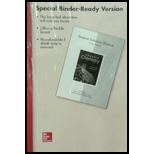
Interpretation:
The alternative resonance structure for each of the given compounds that all the six membered rings correspond to Kekule forms of benzene is to be written.
Concept introduction:
In the Kekulé structure of notation, all the covalent bonds in the compounds are indicated by the lines and does not include lone pairs or formal charge.
This gives rise two possible structures. Two adjacent carbon atoms are joined by a single bond in one structure while the same two adjacent carbon atoms are joined by a double bond in the other structure.
For benzene there two Kekulé structures, that they have the same connectivity of the atoms, but different arrangement of
Want to see the full answer?
Check out a sample textbook solution
Chapter 12 Solutions
Loose Leaf Student Solutions Manual Organic Chemistry
- Biphenyl has the following structure.(a) Is biphenyl a (fused) polynuclear aromatic hydrocarbon?(b) How many pi electrons are there in the two aromatic rings of biphenyl? How does this number compare with that for naphthalene?(c) The heat of hydrogenation for biphenyl is about 418 kJ>mol (100 kcal>mol). Calculate theresonance energy of biphenyl.(d) Compare the resonance energy of biphenyl with that of naphthalene and with that of two benzene rings. Explain thedifference in the resonance energies of naphthalene and biphenyl.arrow_forwardWrite chemical structures for compounds A through D in the following sequence of reac- tions. Compounds A and C are alcohols, one of which is cyclicarrow_forwardIn 1935, J. Bredt, a German chemist, proposed that a bicycloalkene could not have a double bond at a bridgehead carbon unless one of the rings containsat least eight carbons. This is known as Bredt’s rule. Explain why there cannot be a double bond at this position.arrow_forward
- 1-pentanol + HBr -> 1-bromopentane Is this substitution reaction reversible? In other words, would one expect to obtain an equilibrium mixture of the alcohol and bromoalkene at the end of the reaction of would one expect this reaction to go to completion? Justify your answer?arrow_forwardExplain the concept of Hydrogenation Data and Degrees of Unsaturation ?arrow_forwardHow many different monosubstituted products are possible when ethylcyclopentane reacts with one equivalent of bromine in the presence of light?arrow_forward
- Illustrating with equations, indicate how cyclopentene would be converted to tert-butoxycyclopentanearrow_forwardDoes the Wittig reaction to form ethyl cinnamate lead primarily to the cis or trans product?What data support this conclusion? What was the cis/trans product ratio of this reaction?arrow_forwardHow many lone pairs are involved in sustaining the conjugation of pyridine?arrow_forward
- For following substituted benzenes: [1] C6H5Br; [2] C6H5CN; [3] C6H5OCOCH3: On balance, does the substituent make a benzene ring more or lesselectron rich than benzene itself?arrow_forwardHow process of ring-flipping also affects the orientation of cyclohexane's hydrogen atoms ?arrow_forwardWhich of these images are not aromatic?arrow_forward

 Macroscale and Microscale Organic ExperimentsChemistryISBN:9781305577190Author:Kenneth L. Williamson, Katherine M. MastersPublisher:Brooks Cole
Macroscale and Microscale Organic ExperimentsChemistryISBN:9781305577190Author:Kenneth L. Williamson, Katherine M. MastersPublisher:Brooks Cole

